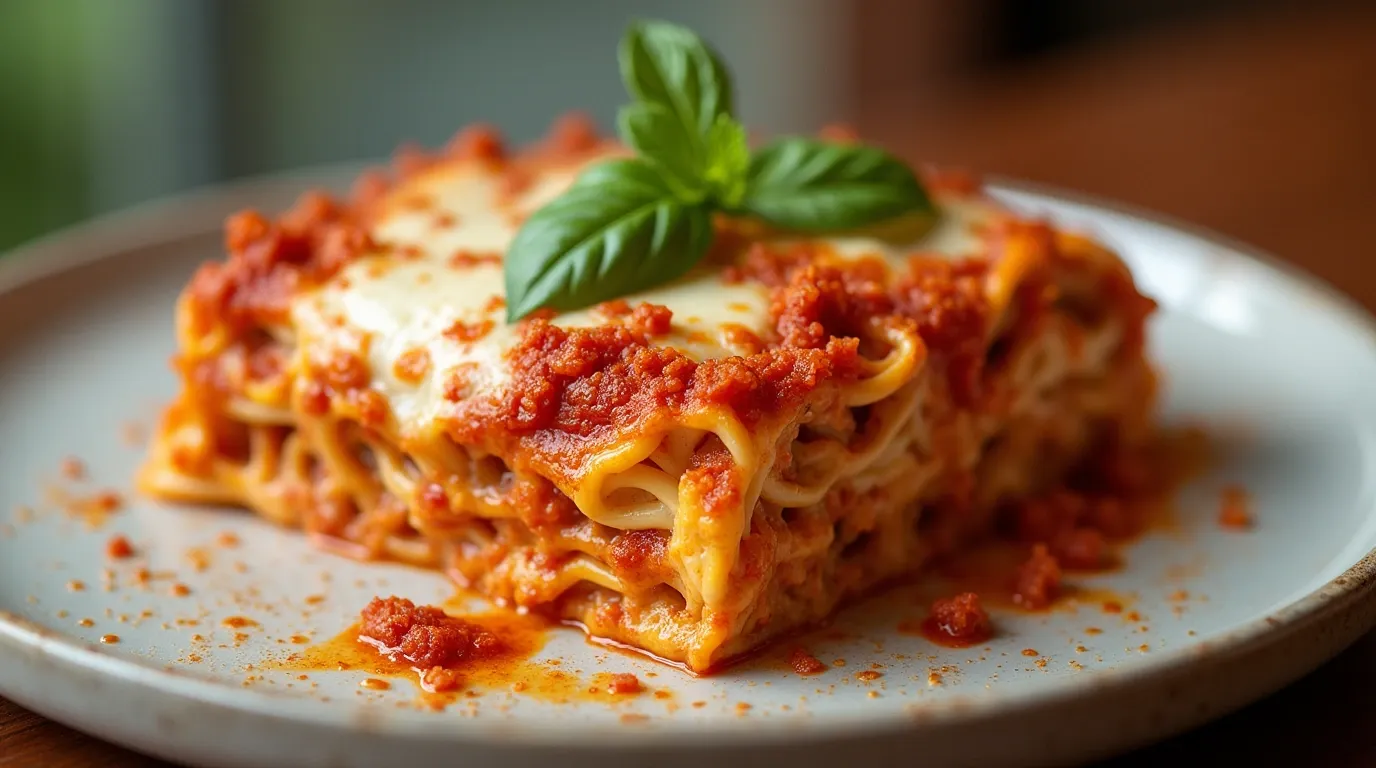Choosing the right pasta for lasagna is key to a great dish. You might wonder What type of pasta is best for lasagna? With many options, picking the right one can be tough. But knowing what makes good lasagna noodles is essential.
Fresh, uncooked pasta sheets are a top choice for lasagna. They blend well with sauce, making the dish tender and flavorful. This makes them a standout option for lasagna pasta.
Lasagna is a beloved dish with a rich history. It has countless variations, allowing for endless creativity in recipes. The pasta you choose greatly affects the dish’s outcome. So, picking the right lasagna noodles is critical.
When picking lasagna noodles, aim for a dish that’s both tasty and fulfilling. The right pasta can elevate your lasagna into a memorable meal. So, what’s the best pasta for lasagna? It depends on your taste and the lasagna you want to make. With some trial and error, you’ll find the perfect noodles for your lasagna.
Understanding Traditional Lasagna Pasta
Traditional lasagna pasta comes from Italy, with a long history in Emilia-Romagna. It’s made from durum wheat semolina flour and water. Choosing the right pasta, sauce, and cheese is key for a classic lasagna.
A traditional lasagna has layers of pasta, meat sauce, and cheese. Ricotta, parmesan, and mozzarella are common cheeses used. Fresh pasta sheets give a better texture and taste than dried ones.
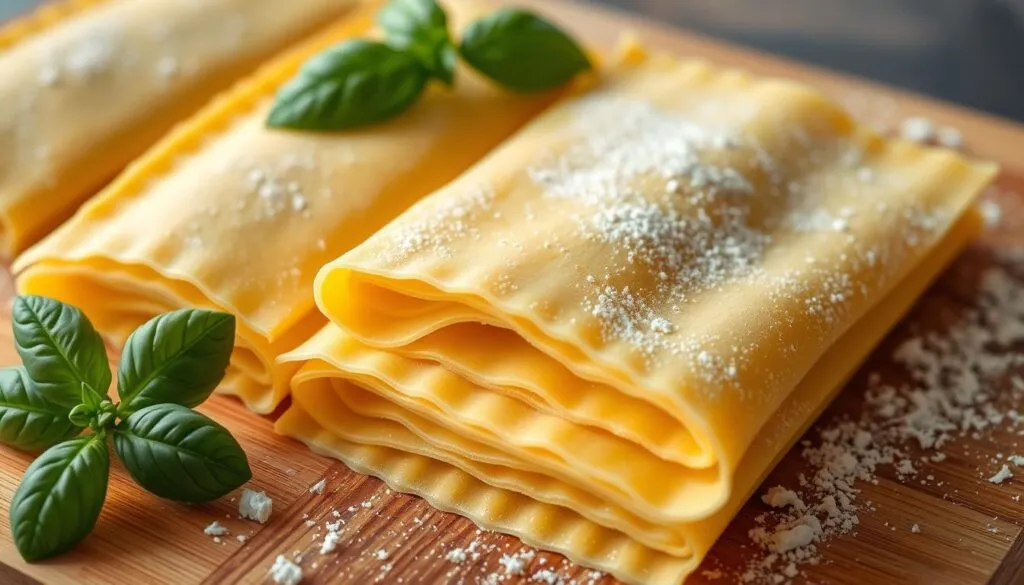
Fresh vs Dried Lasagna Sheets
Fresh lasagna sheets are loved by chefs for their delicate texture and flavor. But, dried sheets are easier to store and use. Always follow the cooking time on the package, usually 7 to 9 minutes.
Traditional Italian Pasta Specifications
Italian pasta must be flat, wide, and rectangular. The pasta’s width and shape are important for a good lasagna. Lasagna pasta is unique and can’t be replaced by other pasta types.
Regional Variations in Lasagna Noodles
Italy has many lasagna noodle variations. From Emilia-Romagna’s flat sheets to curly-edged lasagna riccia, each adds to Italian cuisine’s richness. Exploring different regions’ lasagna recipes is essential for authenticity.
The Different Types of Lasagna Noodles Available
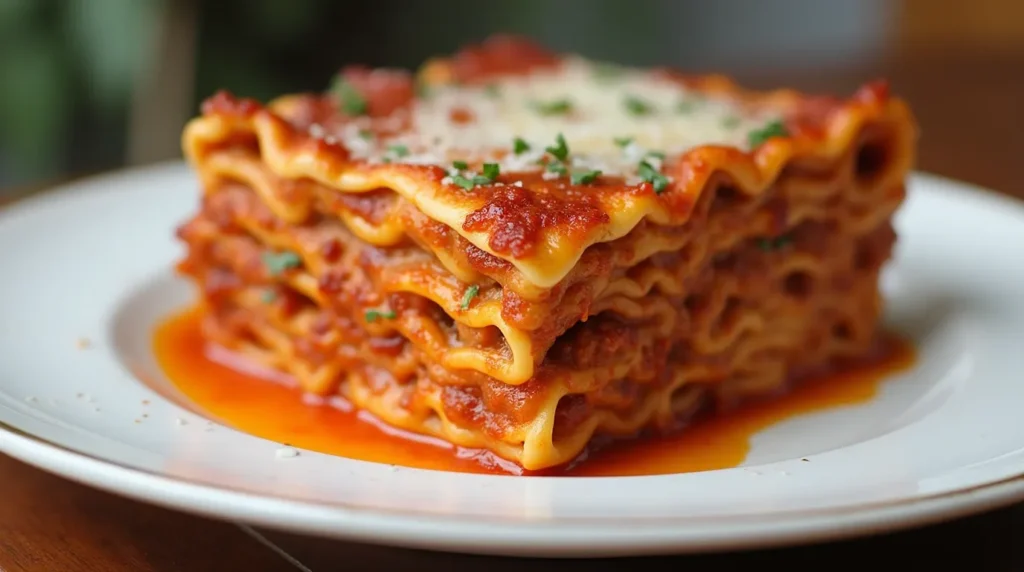
Choosing the right pasta for lasagna can be tricky. There are many shapes, sizes, and materials to pick from. Each type has its own special qualities. Knowing about these can help you make the best lasagna.
In Italy, where lasagna started, different regions have their own noodle preferences. Southern Italy likes dried pasta, while northern Italy, like Bologna, prefers fresh egg pasta with spinach. This variety lets you try new flavors and textures in your lasagna.
Some popular lasagna noodles include:
- Fresh egg pasta sheets, perfect for traditional lasagna recipes
- Dried lasagna noodles, convenient and easy to store
- No-boil lasagna noodles, great for busy cooks who want to save time
- Whole wheat lasagna noodles, a healthier choice compared to traditional noodles
DeLallo offers many lasagna noodle options, like classic, whole wheat, gluten-free, and no-boil. Think about cooking time, texture, and taste when picking the best pasta for lasagna. With so many choices, you can make a lasagna that’s just right for you.
Exploring the different lasagna noodles can elevate your lasagna game. Whether you’re into traditional fresh egg pasta or quick no-boil noodles, there’s something for everyone. So, try out different noodles to find the perfect one for your next Italian dish.
What Type of Pasta is Best for Lasagna? Expert Recommendations
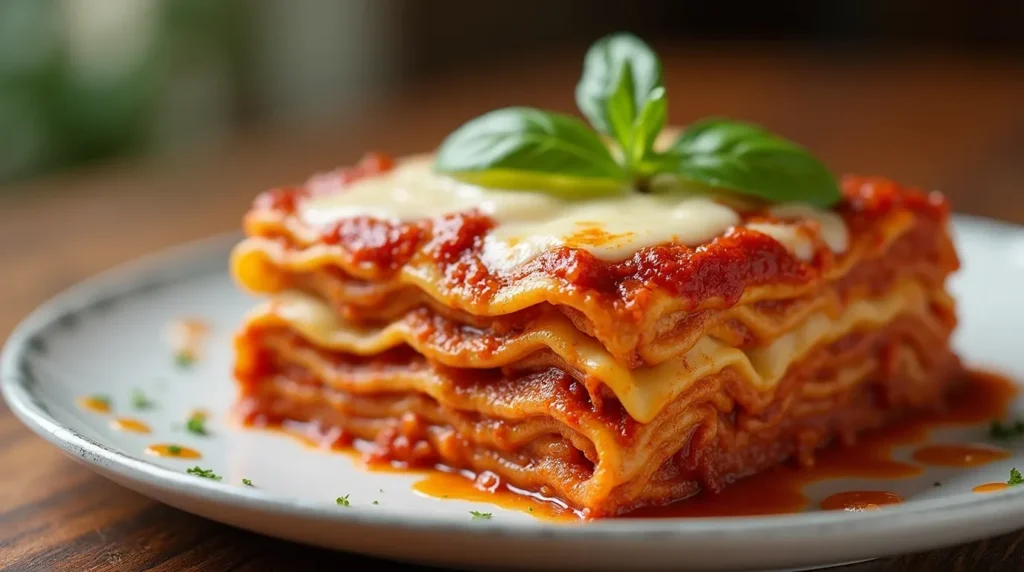
Choosing the right pasta for lasagna is key. It affects the dish’s texture and taste. Here are some expert tips for making a great lasagna.
Popular pasta choices include flat noodles, rippled edge varieties, and no-boil options. Each has its own benefits. For example, flat noodles offer a traditional taste, while rippled edges add texture and look. No-boil options are easy to prepare.
To make the best lasagna, use fresh pasta sheets and layer ingredients right. Bake at 375°F for 25 minutes covered, then 25 minutes uncovered. Let it rest for 15 minutes before slicing.
| Pasta Type | Description | Benefits |
|---|---|---|
| Classic Flat Noodles | Traditional lasagna experience | Easy to cook, classic flavor |
| Rippled Edge Varieties | Added texture and visual appeal | Unique presentation, flavorful |
| No-Boil Options | Convenient, easy to prepare | Saves time, reduces cooking effort |
By following these tips and using the right ingredients, you can make a delicious lasagna. It will surely impress your loved ones.
Fresh Homemade Lasagna Sheets: A Superior Choice
Using fresh homemade lasagna sheets can elevate your lasagna game. They add a delicate texture and enhance the flavor. To make them, you’ll need 1.5 cups of flour, 3 eggs, and 1 tablespoon of olive oil. These sheets are perfect for your favorite lasagna recipe, which often includes ground beef, tomato sauce, and mozzarella cheese.
A traditional lasagna has layers of homemade sheets, bolognese sauce, ricotta cheese, and shredded cheese. Layer these ingredients three times, ending with cheese on top. Bake at 375°F for 30 minutes covered, then 15 minutes uncovered. This way, you’ll get a homemade lasagna that’s sure to impress.
Using homemade lasagna sheets lets you control the ingredients and texture. You can also make a big batch of pasta dough for future lasagnas. This saves time and is great for freezing extra lasagnas. Whether you’re making a classic lasagna or something new, homemade sheets elevate your dish.
Here’s a simple recipe for homemade lasagna sheets:
- 1.5 cups all-purpose flour
- 3 whole eggs
- 1 tablespoon olive oil
These sheets are perfect for your favorite lasagna recipe. You might use ground beef, tomato sauce, and mozzarella cheese. A homemade lasagna is a delicious way to enjoy a meal.
To make a tasty lasagna, combine homemade sheets with your favorite ingredients. This could be ground beef, tomato sauce, and mozzarella cheese. Bake it in the oven for a homemade meal that’s sure to please.
| Lasagna Ingredient | Quantity |
|---|---|
| Ground Beef | 2/3 pound |
| Tomato Sauce | 32 ounces |
| Shredded Mozzarella Cheese | 4 cups |
Store-Bought Options: Comparing Popular Brands
Choosing the right pasta for lasagna can be easy with store-bought options. Many brands are available, making it hard to pick just one. We’ve looked at popular brands to help you decide.
Brands like Barilla and San Remo offer different lasagna noodles. Barilla’s noodles cost $2.20 and have 366 calories, 12.5g protein, and 5mg sodium per 100g. San Remo’s noodles cost $2.00 and have similar nutritional values but more sodium.
| Brand | Price (USD) | Nutritional Value (per 100g) |
|---|---|---|
| Barilla | $2.20 | 366 calories, 12.5g protein, 5mg sodium |
| San Remo | $2.00 | 366 calories, 12.5g protein, 30mg sodium |
| Liguori | $3.20 | 351 calories, 14.5g protein, 0mg sodium |
When picking pasta for lasagna, think about nutritional value, price, and cooking time. By comparing brands, you can find the best noodles for your dish. This way, you’ll enjoy a tasty and fulfilling meal.
Key Features of Quality Lasagna Pasta
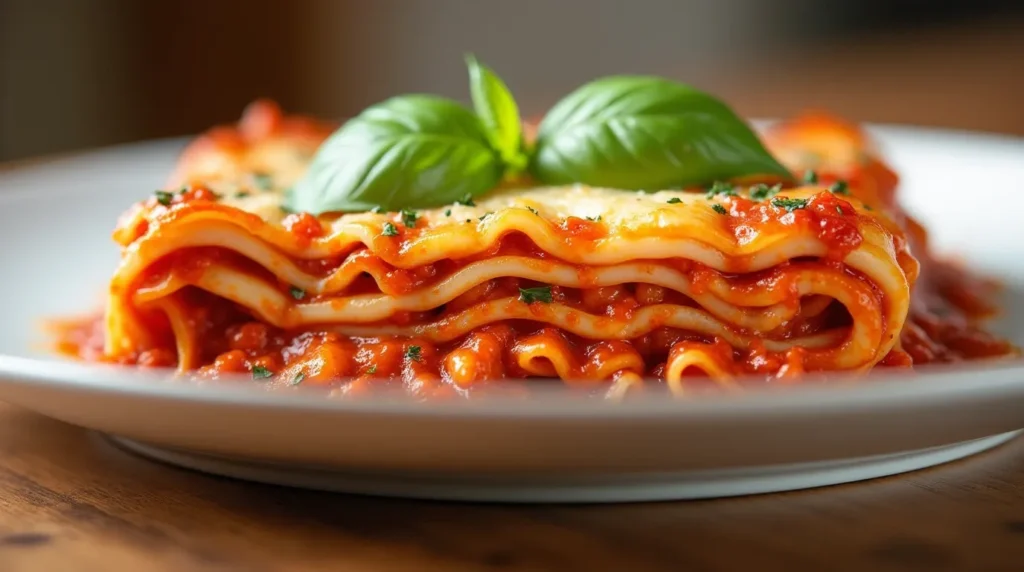
Choosing the right pasta for lasagna is key. You want a traditional lasagna pasta that can handle layers of sauce and cheese. The pasta’s texture and flavor are important for the dish’s taste and structure.
A quality lasagna pasta should be firm and have a mild taste. It should cook just right, not too hard or too soft. Ingredients like meat sauce, ricotta, and mozzarella are essential for a traditional lasagna.
Here are some key features to look for in quality lasagna pasta:
- Texture: The pasta should have a firm texture that will hold up well to the layers of sauce and cheese.
- Flavor: The pasta should have a mild flavor that will not overpower the other ingredients.
- Cooking time: The pasta should have a cooking time that will result in an al dente texture.
Using high-quality lasagna pasta and the right ingredients makes a delicious Italian dish. Whether it’s a classic lasagna or a unique version, the best ingredients and a good recipe are key. With practice, you can make lasagna like a pro and share it with loved ones.
How to Prepare Your Lasagna Noodles Properly
To make a great lasagna, you need to prepare your noodles right. You can cook them by boiling, pre-soaking, or using no-boil noodles. These steps help you get a dish that’s both tasty and has the right texture.
There are a few ways to cook lasagna noodles. Soaking them in hot water takes about 20 minutes, which is quicker than boiling. No-boil noodles are also easy, as they don’t need to be cooked beforehand. You’ll need to pick the right ingredients and know how to prepare them for your lasagna.
Boiling Techniques
Boiling lasagna noodles is a classic method that takes some practice. They usually cook for 10 minutes, but for al dente, you should cook them for about 8 minutes. Adding kosher salt to the water boosts the flavor. Also, a tablespoon of olive oil can stop the noodles from sticking together.
Pre-Soaking Methods
Soaking lasagna noodles before cooking can save time and make them softer. This is great for dry noodles. Soaking them in hot water for 20 minutes helps them cook evenly and prevents them from becoming too hard or too soft.
By following these tips, you can make a delicious lasagna. Choose the right ingredients and prepare your noodles well for the best results.
Alternative Pasta Options for Special Diets
Traditional lasagna pasta is often the first choice for a delicious lasagna. But, for those with special dietary needs, there are other options. These alternatives can be used in many lasagna recipes, tailored to your needs.
Gluten-Free Alternatives
Gluten-free pasta, like quinoa or rice pasta, is a great substitute. It’s perfect for those with gluten intolerance or sensitivity. Brands like Banza and Barilla offer gluten-free pasta options.
Whole Wheat Options
Whole wheat pasta is another alternative. Made with whole wheat flour, it’s higher in fiber and nutrients. It’s a healthier choice for those looking for a better option.
Vegetable-Based Noodles
Vegetable-based noodles, such as zucchini or spiralized vegetables, are low in carbs. They’re low in calories and rich in nutrients. Brands like Veggiecraft Farms and Cece’s Veggie Co offer these options.
| Pasta Type | Calories per serving | Carb content |
|---|---|---|
| Traditional lasagna pasta | 200-250 | 30-40g |
| Gluten-free pasta | 150-200 | 20-30g |
| Whole wheat pasta | 200-250 | 30-40g |
| Vegetable-based noodles | 50-100 | 5-10g |
When picking an alternative pasta, think about the recipe’s ingredients and nutrition. Choosing the right pasta ensures a delicious and healthy lasagna, whether with traditional pasta or alternatives.
Common Mistakes to Avoid When Choosing Lasagna Pasta
Choosing the right pasta is key to a delicious lasagna. To get the best results, follow some basic tips and avoid common mistakes. Using low-quality pasta can ruin the texture and taste. For a great lasagna, use fresh, uncooked pasta sheets.
Other mistakes include overcooking the pasta and using the wrong meat. For example, ground beef can make the dish less flavorful than using pork or Italian sausage. By using the right ingredients and following these tips, you’ll make a lasagna that wows everyone.
Here are some additional tips to keep in mind:
- Use fresh egg pasta for a softer and more compact lasagna.
- Aim for at least 4 layers, with 5 layers preferred for better visual and taste appeal.
- Make your own ragù sauce for a more flavorful dish.
By avoiding common mistakes and following these tips, you can create a delicious lasagna. Always use high-quality ingredients and follow the right techniques for the best results.
| Lasagna Layer | Recommended Ingredient |
|---|---|
| Meat Sauce | Homemade ragù sauce |
| Cheese | Fresh mozzarella |
| Pasta | Fresh egg pasta |
Tips for Storing and Handling Lasagna Noodles
Storing and handling lasagna noodles right is key to keeping them fresh. Whether you’re using store-bought or homemade noodles, the right care can greatly improve your dish.
To keep noodles fresh, store them in an airtight container in a cool, dry spot. This prevents moisture damage and keeps them fresh longer. Fresh pasta should be refrigerated and used within a few days.
Storage Guidelines
Dried lasagna noodles can last up to 2 years in a pantry or cupboard. Always check for damage or moisture before storing. If noodles are damaged, it’s best to throw them out to avoid contamination.
Handling Fresh Pasta
When working with fresh pasta, handle it carefully to avoid damage. You can store it in the fridge for up to 3 days or freeze it for 6 months. Before freezing, thaw frozen pasta overnight in the fridge.
Freezing Instructions
To freeze noodles, lay them flat on a baking sheet and freeze. Then, move them to an airtight container or bag for up to 6 months. To use, thaw them in the fridge overnight before adding to your lasagna.
By following these tips, you can keep your lasagna noodles fresh and high-quality. Whether you’re making a classic lasagna or trying something new, proper storage and handling are essential.
Conclusion: Making the Right Choice for Your Perfect Lasagna
Choosing the rightpasta for lasagna is key to a tasty dish. We’ve seen manytypes of lasagna noodles, each with its own perks. Whether it’s classic flat noodles or rippled ones, pick a qualitylasagna pasta that goes well with your recipe.
Homemade pasta sheets are top-notch for their texture and taste. But, if you’re short on time, store-bought options work great too. Just make sure the pasta’s thickness and cooking method match your lasagna.
How you prepare yourpasta type matters a lot. Boiling, pre-soaking, or using no-boil noodles can greatly improve your lasagna. Also, knowing how to store and handle yourlasagna noodles is important for a great dish.
With the tips from this article, you’re ready to make a fantasticlasagna. It’s sure to wow your loved ones. Bon appétit!
FAQ
What type of pasta is best for lasagna?
The best pasta for lasagna depends on what you like. Traditional lasagna, fresh egg pasta, and gluten-free noodles are all good choices. The key is to pick pasta that tastes great and cooks just right.
What are the differences between fresh and dried lasagna sheets?
Fresh lasagna sheets are loved by chefs for their soft texture and taste. Dried sheets are easier to find and last longer, but they might not taste as good as fresh pasta.
What are the traditional Italian pasta specifications for lasagna?
In Italy, lasagna pasta is a flat, wide noodle made with eggs and flour. It should be firm but soft enough to hold the lasagna’s layers well.
What are the different types of lasagna noodles available?
You can find many types of lasagna noodles. There are flat noodles, noodles with ridges, no-boil options, and even gluten-free or veggie noodles. The type you choose affects the lasagna’s texture and cooking time.
What are the benefits of using fresh homemade lasagna sheets?
Making your own lasagna sheets at home gives you a softer texture and better taste. You can also pick the ingredients and make the pasta just how you like it.
How do popular store-bought lasagna noodle brands compare?
Many brands sell lasagna noodles, including regular, oven-ready, and specialty types. Each brand has its own quality and taste. It’s smart to read reviews and compare to find the best one for your lasagna.
What are the key features to look for in quality lasagna pasta?
Look for lasagna pasta that’s firm but soft, tastes rich, and cooks just right. This ensures it holds up well in your lasagna.
What are the best methods for preparing lasagna noodles?
You can boil, pre-soak, or use no-boil noodles for lasagna. The right method makes the noodles perfect for layering in your lasagna.
What alternative pasta options are available for special diets?
For special diets, there are gluten-free, whole wheat, and veggie noodles. They’re great for making lasagna that fits your dietary needs.
What are the most common mistakes to avoid when choosing lasagna pasta?
Avoid using low-quality pasta, overcooking, and not preparing the pasta right. Following best practices helps your lasagna turn out great.
How should lasagna noodles be stored and handled?
Storing and handling lasagna noodles right keeps them fresh and good. Follow storage tips, handle fresh pasta gently, and freeze if needed.

